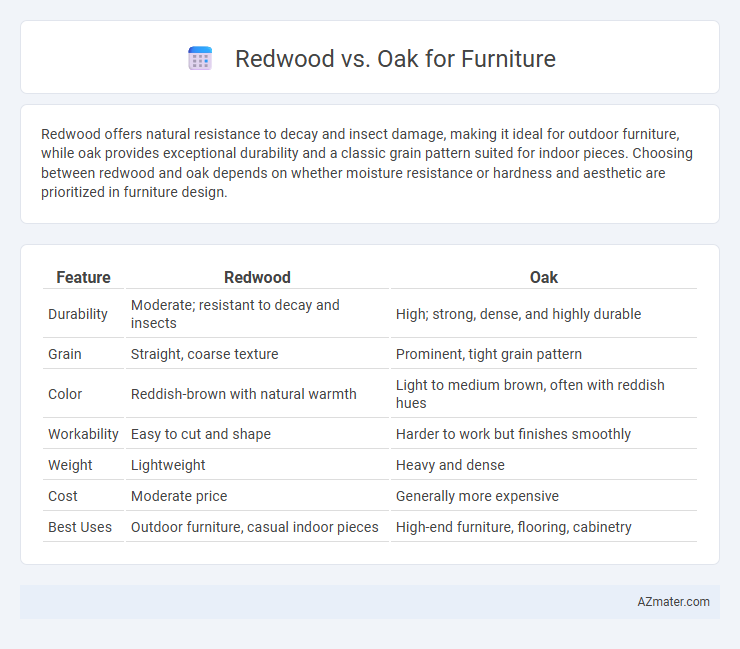Redwood offers natural resistance to decay and insect damage, making it ideal for outdoor furniture, while oak provides exceptional durability and a classic grain pattern suited for indoor pieces. Choosing between redwood and oak depends on whether moisture resistance or hardness and aesthetic are prioritized in furniture design.
Table of Comparison
| Feature | Redwood | Oak |
|---|---|---|
| Durability | Moderate; resistant to decay and insects | High; strong, dense, and highly durable |
| Grain | Straight, coarse texture | Prominent, tight grain pattern |
| Color | Reddish-brown with natural warmth | Light to medium brown, often with reddish hues |
| Workability | Easy to cut and shape | Harder to work but finishes smoothly |
| Weight | Lightweight | Heavy and dense |
| Cost | Moderate price | Generally more expensive |
| Best Uses | Outdoor furniture, casual indoor pieces | High-end furniture, flooring, cabinetry |
Introduction: Redwood vs Oak for Furniture
Redwood and oak are popular hardwood choices for furniture, each with distinct characteristics influencing durability, appearance, and maintenance. Redwood offers natural resistance to decay and insects, featuring a rich reddish hue and straight grain, making it ideal for outdoor and rustic indoor furniture. Oak provides exceptional strength and a prominent grain pattern, favored for classic and sturdy furniture designs that withstand everyday wear.
Appearance and Grain Patterns
Redwood offers a rich reddish-brown hue with a straight, uniform grain that creates a sleek and modern look in furniture design. Oak features a lighter golden or pale brown color and is characterized by its prominent, coarse grain patterns with distinctive swirls and rays, lending a classic and textured aesthetic. These grain and color differences impact furniture style choices, with redwood suiting contemporary designs and oak favored for traditional or rustic pieces.
Durability and Strength Comparison
Redwood offers moderate durability and resistance to decay, making it suitable for indoor and some outdoor furniture, while oak is known for exceptional hardness and strength, providing long-lasting performance in heavy-use furniture pieces. Oak's dense grain structure enhances its resistance to wear and dents, outperforming redwood in strength for high-traffic applications. Choosing oak ensures superior structural integrity and longevity, whereas redwood is preferred for its lightweight nature and natural resistance to moisture and insects.
Workability and Ease of Crafting
Redwood is prized for its lightweight texture and straight grain, making it easier to cut, shape, and sand, which suits intricate furniture designs. Oak, known for its density and hardness, offers superior durability but requires more effort and sharper tools during crafting to achieve smooth finishes. Both woods present unique challenges and benefits, with redwood favored for ease of workability and oak preferred when strength and longevity are priorities.
Weight and Density Differences
Redwood furniture is significantly lighter than oak due to its lower density, typically ranging from 26 to 31 pounds per cubic foot compared to oak's 44 to 47 pounds per cubic foot. This difference in weight makes redwood easier to move and ideal for outdoor furniture, while oak's higher density provides greater durability and strength for heavy-use indoor pieces. The density variation also affects the overall longevity and maintenance, with oak generally offering superior resistance to dents and scratches.
Resistance to Decay and Insects
Redwood offers superior natural resistance to decay and insects due to its high tannin content and natural oils, making it ideal for outdoor furniture exposed to moisture and pests. Oak, while strong and durable, is more susceptible to fungal decay and insect infestation unless properly treated or sealed. For long-lasting furniture with minimal maintenance, redwood outperforms oak in resisting decay and insect damage.
Environmental Impact and Sustainability
Redwood furniture offers significant environmental benefits due to its natural resistance to decay, reducing the need for chemical treatments and extending product lifespan. Oak, while durable and long-lasting, is often harvested from slower-growing trees, which can contribute to deforestation and habitat disruption when not sourced sustainably. Choosing FSC-certified Redwood or Oak ensures responsible forestry practices, promoting sustainability and reducing overall ecological footprints in furniture production.
Cost and Availability
Redwood furniture typically costs more due to its premium quality and limited regional availability, predominantly sourced from the western United States. Oak is more widely available and generally more affordable, benefiting from extensive growth across North America and Europe. The price difference reflects oak's durability and abundant supply compared to redwood's aesthetic appeal and scarcity.
Best Uses for Redwood and Oak in Furniture
Redwood is ideal for outdoor furniture due to its natural resistance to moisture, decay, and insect damage, making it perfect for decks, patio sets, and garden benches. Oak offers exceptional strength and durability, with a dense grain that suits indoor furniture such as dining tables, chairs, and cabinetry, providing a classic, timeless appearance. Both woods benefit from their distinct properties: redwood excels in weather resistance while oak delivers structural integrity and refined aesthetics.
Conclusion: Choosing Between Redwood and Oak
Redwood offers superior resistance to decay and insect damage, making it ideal for outdoor furniture, while oak provides exceptional strength and a classic grain pattern suited for indoor pieces. Oak's density and durability contribute to long-lasting, traditional aesthetics, whereas redwood's lighter weight and natural oils enhance weather resistance. Selecting between redwood and oak depends on furniture use, environmental exposure, and desired appearance, with each wood excelling in distinct applications.

Infographic: Redwood vs Oak for Furniture
 azmater.com
azmater.com